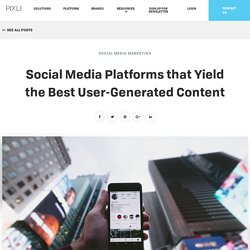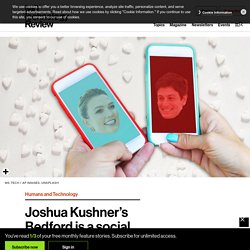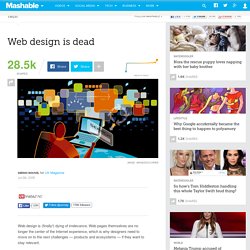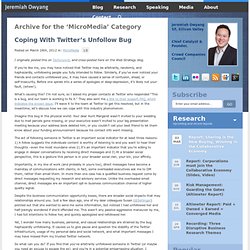

Social Media Platforms that Yield the Best User-Generated Content - The Pixlee Blog. Don’t be afraid to go outside the box to find appealing content User-generated content is possibly one of the greatest hallmarks of social media platforms.

With the rise of smartphones, every user has become their own publisher. The overwhelming popularity of social media platforms like Facebook, Instagram, YouTube, and Twitter each represent unique facets of your community and offer content that can be used in dynamic ways. Since UGC can be turned into actionable experiences on your website, emails, advertising, and even in-store, there’s no reason to limit your content nurturing to a few platforms, but knowing which social platforms yield the best content for your brand, and how to use that content is key to seamlessly providing the best experience for your customers. Instagram is a great social media platform for harvesting the best UGC. Morphe features high-quality UGC from their Instagram community in product pages. Morphe uses UGC in Facebook ads to sell more. Twitter YouTube. Joshua Kushner’s Bedford is a social network for just two people.
On Valentine’s Day, Joshua Kushner—brother of Jared Kushner, senior advisor and son-in-law to President Donald Trump—announced the release of an app, Bedford, via his Instagram and Twitter pages, complete with a heart-eye emoji.

“For some time, I have been thinking about what it would be like to have a space on my phone for just Karlie and myself,” the post reads, referring to Kushner’s wife, supermodel Karlie Kloss. The post describes how Kushner spent the past few months creating a private messaging app designed to let you interact via text, video, and photo with the single most important person in your life—“a partner, friend, parent, grandparent, etc.” Posts disappear 48 hours later. Bedford is not the only new app designed to change our relationship with social media by creating safe, intimate spaces for just a few select people. November saw the debut of Cocoon, a network—founded by two former employees of Facebook—that connects up to 12 family members. Google, Facebook and the World's Biggest Brands Join Together to Improve Digital Ads. The digital advertising world is getting its act together thanks to the ad-blocking epidemic, which is hurting revenues across the industry.

The Coalition for Better Ads was announced today in Cologne, Germany, where the Dmexco conference has been taking place this week. The coalition's founding members include Google, Facebook, Procter & Gamble, Unilever, the 4As, the Association of National Advertisers, the World Federation of Advertisers, The Washington Post, GroupM and the Interactive Advertising Bureau. The consortium aims to monitor the quality of online advertising using technology currently being developed at the IAB's Tech Lab. Digital ad campaigns will be scored on everything from creative to load time, and the coalition will come up with standards based on data gleaned from the system as well as from consumer feedback and input from marketers.
Google's Messenger App Doesn't Have Ads, but Marketers Are Intrigued Anyway. Google wants in on the mobile-messaging craze.

Today, the Mountain View, Calif., company launched Allo, its messaging app that layers artificial intelligence over photos, texts and stickers users send each other. Allo is Google's first stab at artificial intelligence. It was announced at the company's annual I/O conference in May. Similar to Facebook Messenger, Snapchat, WhatsApp and Apple's iMessage, Allo is a chat app that lets consumers swap self-destructing messages with each other.
But it also includes Google-powered search features. Rachel Pasqua, head of connected life at MEC North America, said she expects Google to roll out branded emojis for marketers. "The AI feature will recommend a sponsor based on the keyword, the message and the conversational flow," she said. #SocialSkim: Twitter Rebuilding, Google Rejoins Messaging Wars: 13 Stories This Week. Web design is dead. Web design is (finally!)

Dying of irrelevance. Web pages themselves are no longer the center of the Internet experience, which is why designers need to move on to the next challenges — products and ecosystems — if they want to stay relevant. Web design has no future — a risky statement I know, but this article explains why it has no future and what we, as designers, can do about it. As a discipline, web design has already exhausted its possibilities, an emerging combination of tech and cultural trends highlight the need for a broader approach.
Let's start with the symptoms of this imminent death. Symptom 1: Commoditization by templates Most of the content that you see on the web today is run by some framework or service — WordPress, Blogger, Drupal, you name it. As a consequence of the ubiquity of these frameworks, a whole world of free and paid templates lets you get started with a professional-looking design in minutes. Symptom 2: Web design patterns are mature Even more: Digital media infographics. MicroMedia. I originally posted this on Techcrunch, and cross-posted here on the Web Strategy blog.

If you’re like me, you may have noticed that Twitter may be arbitrarily, randomly, and haphazardly, unfollowing people you fully intended to follow. Similarly, if you’ve ever noticed your friends and contacts unfollowed you, it may have caused a sense of confusion, dread, or self-insecurity. Before one spirals into a series of apologies or deep-depression, it’s likely not your fault, (whew!). What’s causing this? I’m not sure, so I asked my proper contacts at Twitter who responded “This is a bug, and our team is working to fix it.” Imagine this bug in the physical world: Your dear Aunt Margaret wasn’t invited to your wedding due to mail parcels gone missing, or your executive wasn’t invited to your big presentation meeting because your address book deleted him, or you couldn’t call your best friend to let them know about your funding announcement because his contact info went missing.
Infographics.